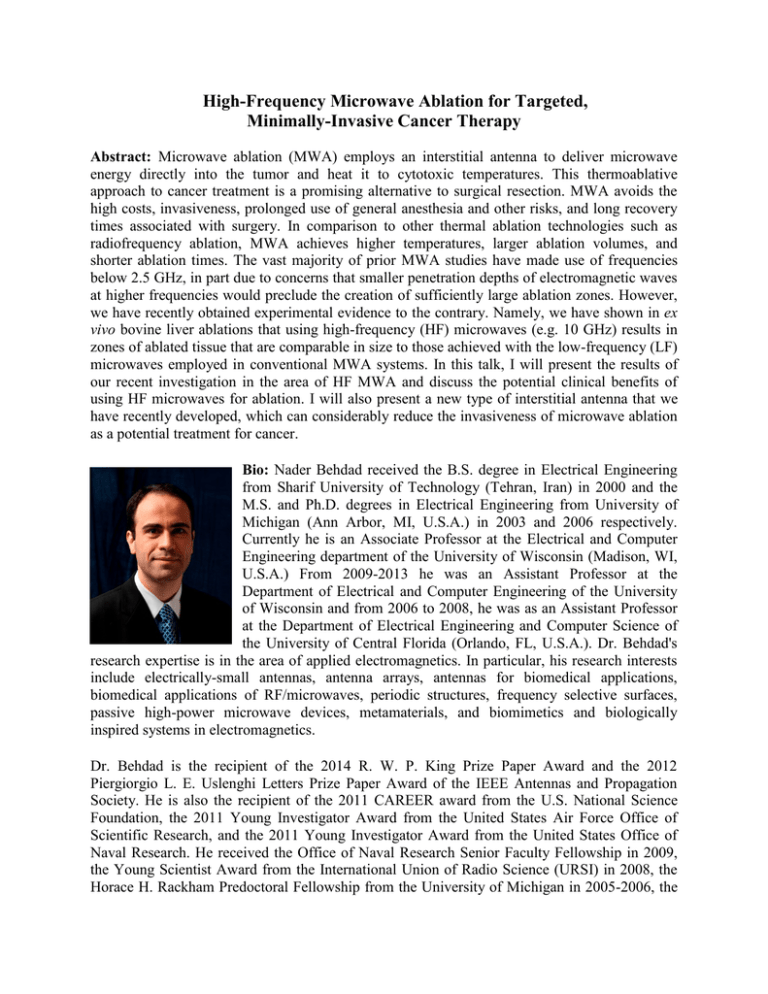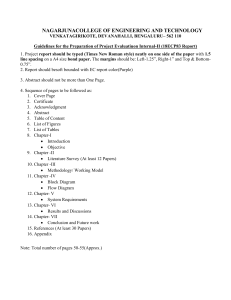High-Frequency Microwave Ablation for Targeted, Minimally
advertisement

High-Frequency Microwave Ablation for Targeted, Minimally-Invasive Cancer Therapy Abstract: Microwave ablation (MWA) employs an interstitial antenna to deliver microwave energy directly into the tumor and heat it to cytotoxic temperatures. This thermoablative approach to cancer treatment is a promising alternative to surgical resection. MWA avoids the high costs, invasiveness, prolonged use of general anesthesia and other risks, and long recovery times associated with surgery. In comparison to other thermal ablation technologies such as radiofrequency ablation, MWA achieves higher temperatures, larger ablation volumes, and shorter ablation times. The vast majority of prior MWA studies have made use of frequencies below 2.5 GHz, in part due to concerns that smaller penetration depths of electromagnetic waves at higher frequencies would preclude the creation of sufficiently large ablation zones. However, we have recently obtained experimental evidence to the contrary. Namely, we have shown in ex vivo bovine liver ablations that using high-frequency (HF) microwaves (e.g. 10 GHz) results in zones of ablated tissue that are comparable in size to those achieved with the low-frequency (LF) microwaves employed in conventional MWA systems. In this talk, I will present the results of our recent investigation in the area of HF MWA and discuss the potential clinical benefits of using HF microwaves for ablation. I will also present a new type of interstitial antenna that we have recently developed, which can considerably reduce the invasiveness of microwave ablation as a potential treatment for cancer. Bio: Nader Behdad received the B.S. degree in Electrical Engineering from Sharif University of Technology (Tehran, Iran) in 2000 and the M.S. and Ph.D. degrees in Electrical Engineering from University of Michigan (Ann Arbor, MI, U.S.A.) in 2003 and 2006 respectively. Currently he is an Associate Professor at the Electrical and Computer Engineering department of the University of Wisconsin (Madison, WI, U.S.A.) From 2009-2013 he was an Assistant Professor at the Department of Electrical and Computer Engineering of the University of Wisconsin and from 2006 to 2008, he was as an Assistant Professor at the Department of Electrical Engineering and Computer Science of the University of Central Florida (Orlando, FL, U.S.A.). Dr. Behdad's research expertise is in the area of applied electromagnetics. In particular, his research interests include electrically-small antennas, antenna arrays, antennas for biomedical applications, biomedical applications of RF/microwaves, periodic structures, frequency selective surfaces, passive high-power microwave devices, metamaterials, and biomimetics and biologically inspired systems in electromagnetics. Dr. Behdad is the recipient of the 2014 R. W. P. King Prize Paper Award and the 2012 Piergiorgio L. E. Uslenghi Letters Prize Paper Award of the IEEE Antennas and Propagation Society. He is also the recipient of the 2011 CAREER award from the U.S. National Science Foundation, the 2011 Young Investigator Award from the United States Air Force Office of Scientific Research, and the 2011 Young Investigator Award from the United States Office of Naval Research. He received the Office of Naval Research Senior Faculty Fellowship in 2009, the Young Scientist Award from the International Union of Radio Science (URSI) in 2008, the Horace H. Rackham Predoctoral Fellowship from the University of Michigan in 2005-2006, the best paper awards in the Antenna Applications Symposium in Sep. 2003, and the second prize in the paper competition of the USNC/ URSI National Radio Science Meeting, Boulder, CO, in January 2004. His graduate students were the recipients of the ten different awards/recognitions at the IEEE Pulsed Power & Plasma Science (2013), IEEE AP-S/URSI Symposium (2010, 2012, 2013, 2014), and the Antenna Applications Symposium (2008, 2010, 2011). Dr. Behdad is currently serving as an Associate Editor for IEEE Antennas and Wireless Propagation Letters and served as the co-chair of the technical program committee of the 2012 IEEE International Symposium on Antennas and Propagation and USNC/URSI National Radio Science Meeting.

